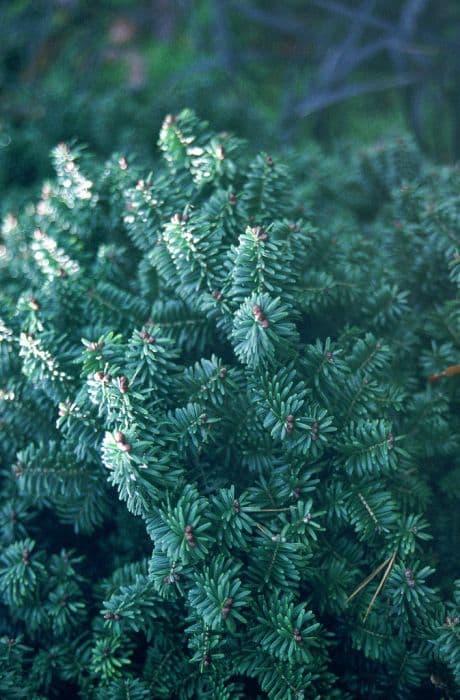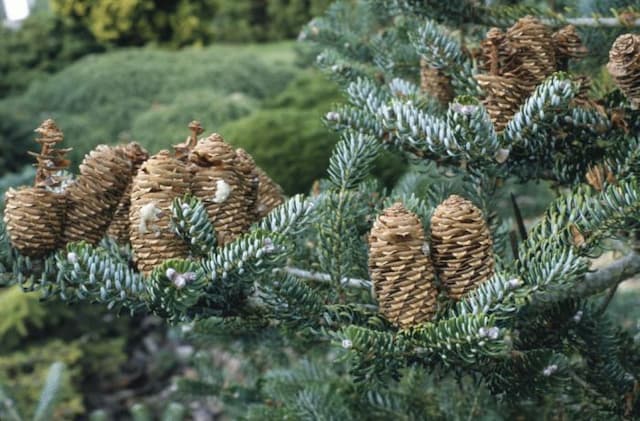European larch Larix decidua

ABOUT
The European larch, as it is commonly called, is a decidigious conifer, which means it sheds its needles annually. It has a distinctive, spire-like shape with a straight trunk. Its bark is flaky, with a reddish-brown color on young trees which gradually turns to a rugged gray-brown with age. The branches of the European larch angle upwards, and during the growing season, they bear soft, bright green needles. These needles turn a striking golden yellow before they fall off in autumn. The plant produces both male and female cones; the male cones are small, yellow, and spherical, while the female cones are red when young and mature to a woody brown color, resembling small, upright, egg-shaped structures. The mature cones open to release seeds but can also remain on the branches for a long time before dropping to the ground. The overall appearance of the European larch is quite graceful, with its colorful foliage in spring and fall and its textured bark providing year-round interest.
About this plant
 Names
NamesFamily
Pinaceae.
Synonyms
European Larch, Common Larch, Alpine Larch.
Common names
Larix europaea, Larix decidua var. polonica, Pinus larix, Abies larix, Larix decidua subsp. sudetica, Larix decidua var. carpatica, Larix decidua var. sudetica.
 Toxicity
ToxicityTo humans
European Larch is not commonly known as a toxic plant to humans. There are no well-documented toxic effects of European Larch upon ingestion by humans.
To pets
European Larch is not widely recognized as a toxic plant to pets. There is limited information on its toxicity to animals, but it is not generally listed among plants that are known to be poisonous to pets. Therefore, no specific symptoms of poisoning from European Larch are commonly reported.
 Characteristics
CharacteristicsLife cycle
Perennials
Foliage type
Deciduous
Color of leaves
Green
Height
70 feet (21.3 meters)
Spread
30 feet (9.1 meters)
Plant type
Tree
Hardiness zones
2
Native area
Europe
Benefits
 General Benefits
General Benefits- Ornamental Value: Larix decidua, commonly known as the European larch, is often used in landscaping for its aesthetic appeal, particularly its conical shape and bright green foliage that turns golden yellow in autumn before dropping.
- Timber Production: European larch wood is valued for its strength, durability, and resistance to rot, making it ideal for construction, carpentry, and outdoor uses such as decking and fencing.
- Wildlife Habitat: The European larch provides habitat and nesting sites for various bird species and its cones offer a source of food for wildlife.
- Erosion Control: With its extensive root system, the European larch can help stabilize soil and prevent erosion, particularly in mountainous regions where it is often found.
- Climate Tolerance: Adaptable to a wide range of climate conditions, Larix decidua can thrive in cold climates, making it suitable for northern latitudes and high-elevation landscapes.
- Soil Improvement: As a deciduous conifer, the European larch cycles nutrients through shedding needles which decompose and enrich the soil around it.
 Medical Properties
Medical Properties- Anti-inflammatory: Larix decidua, commonly known as the European larch, contains compounds that may exhibit anti-inflammatory effects.
- Expectorant: The resin of the European larch has been traditionally used as an expectorant to help relieve chest congestion.
- Diuretic: Some components of the European larch may promote increased urine production and act as a diuretic.
- Antiseptic: The resin, particularly in the form of an oil known as Venice turpentine, has been used for its antiseptic properties.
 Air-purifying Qualities
Air-purifying QualitiesThis plant is not specifically known for air purifying qualities.
 Other Uses
Other Uses- Larix decidua, commonly known as European Larch, has wood that is valued for its tough, waterproof, and durable qualities, making it a preferred material for building yachts and small boats.
- The tree's resin is traditionally used in the making of varnishes and paints, due to its excellent protective and adhesive properties.
- European Larch is used in the manufacturing of Venice Turpentine, a product used in oil painting mediums, and as an additive in the care of horses' hooves.
- The wood of European Larch is also well-suited for outdoor use, such as in the construction of fences, decking, and garden furniture due to its natural resistance to decay.
- The tree is sometimes planted in windbreaks and shelterbelts as its dense foliage and fast-growing nature provide good protection against wind.
- In landscape architecture, the European Larch is used for its aesthetic appeal, particularly its vibrant autumn colors and attractive conical shape.
- The needles of the European Larch are used as a source of bedding material for livestock, as they are soft and have a pleasant scent.
- Wood from the European Larch is utilized in the making of musical instruments like the sound boards of pianos and the bodies of some string instruments for its resonant qualities.
- In forestry, the European Larch is often used for reforestation and afforestation projects because it grows rapidly and adapts well to a variety of soils.
- Larch sawdust and chips can be used as a mulch for paths and garden beds, helping to suppress weeds and maintain soil moisture.
Interesting Facts
 Feng Shui
Feng ShuiThe European Larch is not used in Feng Shui practice.
 Plant Symbolism
Plant Symbolism- Renewal and Flexibility: As a deciduous conifer, the European larch (Larix decidua) sheds its needles in the fall and grows new ones in spring, symbolizing the ability to renew oneself and adapt to changes.
- Endurance and Longevity: With a lifespan that can extend over hundreds of years, the European larch represents enduring through hardships and maintaining strength over time.
- Protection: Historically, its durable wood was used in construction, including for building Alpine chalets, signifying solidity and protection against adversity.
- Hope: The bright green of its new needles in spring reflects hope and the promise of new beginnings.
 Water
WaterEuropean Larch requires consistent moisture, especially during the growing season. It should be watered thoroughly once a week, allowing the soil to become slightly dry between waterings. An average mature tree in a landscape setting might need approximately 15 to 20 gallons of water per week, depending on the climate and soil conditions. During particularly hot or dry periods, the frequency may need to increase to prevent stress. However, overwatering can be detrimental, so ensure good drainage to avoid waterlogged roots.
 Light
LightThe European Larch thrives in full sunlight, needing at least six hours of direct, unfiltered sunlight each day. The best spot for planting is an open area away from buildings or larger trees that might cast shade, to ensure it receives ample light throughout the day.
 Temperature
TemperatureEuropean Larch is adapted to a wide range of temperatures, capable of withstanding winter colds down to -30 degrees Fahrenheit, and summer highs that typically do not exceed 90 degrees Fahrenheit. The ideal growing conditions for the European Larch would be in a climate where temperatures stay between 60 and 70 degrees Fahrenheit during the growing season.
 Pruning
PruningEuropean Larch should be pruned to maintain its shape and remove any dead or damaged branches. Pruning is best done in late winter or early spring, before new growth starts. Annual pruning is usually adequate, focusing on maintaining a desirable form and removing any unwanted branches. Pruning the European Larch during its dormant season reduces sap loss and stress on the tree.
 Cleaning
CleaningAs needed
 Soil
SoilThe European larch (Larix decidua) thrives best in a deep, well-drained, acidic to neutral soil mix with a pH of 5.0 to 7.0. A combination of loam, peat, sand, and aged conifer bark will create an ideal environment for its roots to develop. Regular organic matter addition can help maintain soil fertility.
 Repotting
RepottingEuropean larches, while young, may need repotting every 2-3 years; mature larches should be repotted less frequently, around once every 4-5 years, during the late winter or early spring before new growth begins.
 Humidity & Misting
Humidity & MistingEuropean larches are adaptable but prefer moderate ambient humidity levels; however, they are tolerant to a wide range of outdoor humidity conditions typical of temperate climates.
 Suitable locations
Suitable locationsIndoor
Not ideal to grow indoors; needs outdoor conditions.
Outdoor
Plant in full sun, well-drained soil, and exposed to nature's elements.
Hardiness zone
2-6 USDA
 Life cycle
Life cycleEuropean larch (Larix decidua) begins its life as a seed, which requires a period of cold stratification to germinate. Upon sprouting, the seedling establishes itself and grows into a young tree, developing a deep taproot and a straight stem. As a deciduous conifer, it undergoes an annual cycle of needle-like leaf growth in the spring, which it then sheds in the autumn, revealing distinctive spiky cones. In its maturation phase, which can take several decades, the European larch reaches full size, produces cones with seeds, and becomes reproductive, typically forming a pyramidal canopy. After reaching maturity, the tree can live for up to several hundred years, continually reproducing through its wind-dispersed seeds. Finally, when the European larch completes its life cycle, it dies, decomposes, and contributes to the nutrient cycle of the forest ecosystem.
 Propogation
PropogationPropogation time
Spring-summer
Propogation: The European Larch, scientifically known as Larix decidua, has several propagation methods, but the most popular and effective way to propagate this deciduous conifer is through seed germination. To do this, the seeds should be collected from the cones in late summer to fall, once the cones have matured. The seeds require a period of cold stratification to mimic winter conditions and break dormancy; this can be achieved by mixing the seeds with moist sand and refrigerating them at approximately 34-40 degrees Fahrenheit (1-4 degrees Celsius) for about one to two months. After cold stratification, the seeds can be sown in well-drained soil and kept at a temperature of 65-70 degrees Fahrenheit (18-21 degrees Celsius). Seedlings will typically appear in the spring, and it's crucial to provide them with ample light and protection from harsh conditions until they are strong enough to be transplanted outdoors.









